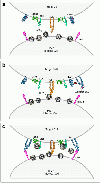HIV-1 envelope, integrins and co-receptor use in mucosal transmission of HIV
- PMID: 21284901
- PMCID: PMC3105502
- DOI: 10.1186/1479-5876-9-S1-S2
HIV-1 envelope, integrins and co-receptor use in mucosal transmission of HIV
Abstract
It is well established that HIV-1 infection typically involves an interaction between the viral envelope protein gp120/41 and the CD4 molecule followed by a second interaction with a chemokine receptor, usually CCR5 or CXCR4. In the early stages of an HIV-1 infection CCR5 using viruses (R5 viruses) predominate. In some viral subtypes there is a propensity to switch to CXCR4 usage (X4 viruses). The receptor switch occurs in ~ 40% of the infected individuals and is associated with faster disease progression. This holds for subtypes B and D, but occurs less frequently in subtypes A and C. There are several hypotheses to explain the preferential transmission of R5 viruses and the mechanisms that lead to switching of co-receptor usage; however, there is no definitive explanation for either. One important consideration regarding transmission is that signaling by R5 gp120 may facilitate transmission of R5 viruses by inducing a permissive environment for HIV replication. In the case of sexual transmission, infection by HIV requires the virus to breach the mucosal barrier to gain access to the immune cell targets that it infects; however, the immediate events that follow HIV exposure at genital mucosal sites are not well understood. Upon transmission, the HIV quasispecies that is replicating in an infected donor contracts through a "genetic bottleneck", and often infection results from a single infectious event. Many details surrounding this initial infection remain unresolved. In mucosal tissues, CD4(+) T cells express high levels of CCR5, and a subset of these CD4(+)/CCR5(high) cells express the integrin α₄β₇, the gut homing receptor. CD4(+)/CCR5(high)/ α4β7(high) T cells are highly susceptible to infection by HIV-1 and are ideal targets for an efficient productive infection at the point of transmission. In this context we have demonstrated that the HIV-1 envelope protein gp120 binds to α₄β₇ on CD4(+) T cells. On CD4(+)/CCR5(high)/ α4β7(high) T cells, α₄β₇ is closely associated with CD4 and CCR5. Furthermore, α₄β₇ is ~3 times the size of CD4 on the cell surface, that makes it a prominent receptor for an efficient virus capture. gp120-α₄β₇ interactions mediate the activation of the adhesion-associated integrin LFA-1. LFA-1 facilitates the formation of virological synapses and cell-to-cell spread of HIV-1. gp120 binding to α₄β₇ is mediated by a tripeptide located in the V1/V2 domain of gp120. Of note, the V1/V2 domain of gp120 has been linked to variations in transmission fitness among viral isolates raising the intriguing possibility that gp120-α₄β₇ interactions may be linked to transmission fitness. Although many details remain unresolved, we hypothesize that gp120-α₄β₇ interactions play an important role in the very early events following sexual transmission of HIV and may have important implication in the design of vaccine strategies for the prevention of acquisition of HIV infection.
Figures



References
Publication types
MeSH terms
Substances
LinkOut - more resources
Full Text Sources
Other Literature Sources
Medical
Research Materials

